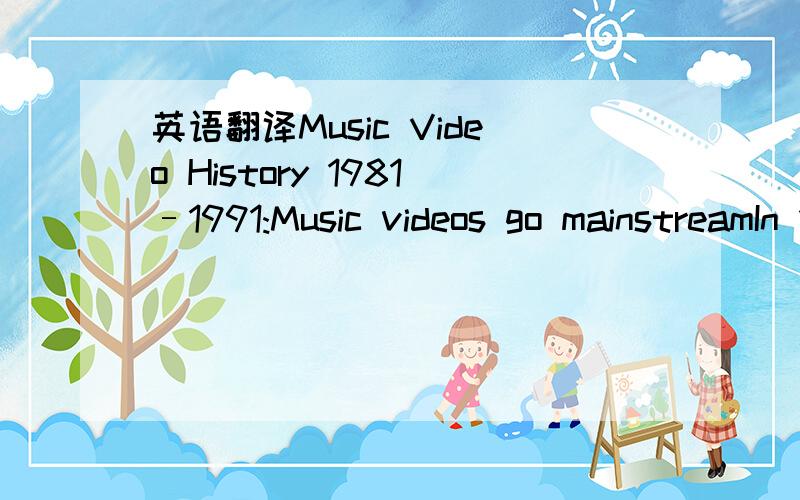英语翻译Music Video History 1981–1991:Music videos go mainstreamIn 1981,the U.S.video channel MTV launched,airing "Video Killed the Radio Star" and beginning an era of 24-hour-a-day music on television.With this new outlet for material,the musi
来源:学生作业帮助网 编辑:作业帮 时间:2024/11/24 20:54:09

英语翻译Music Video History 1981–1991:Music videos go mainstreamIn 1981,the U.S.video channel MTV launched,airing "Video Killed the Radio Star" and beginning an era of 24-hour-a-day music on television.With this new outlet for material,the musi
英语翻译
Music Video History 1981–1991:Music videos go mainstream
In 1981,the U.S.video channel MTV launched,airing "Video Killed the Radio Star" and beginning an era of 24-hour-a-day music on television.With this new outlet for material,the music video would,by the mid-1980s,grow to play a central role in popular music marketing.Many important acts of this period,most notably Adam & the Ants,Madonna and Mylène Farmer,owed a great deal of their success to the skillful construction and seductive appeal of their videos.Some academics[who?] have compared music video to silent film,and it is suggested that stars like Madonna have (often quite deliberately) constructed an image that in many ways echoes the image of the great stars of the silent era such as Greta Garbo.
Two key innovations in the development of the modern music video were the development of relatively inexpensive and easy-to-use video recording and editing equipment,and the development of a number of related effects such as chroma-key.[citation needed] The advent of high-quality color videotape recorders and portable video cameras coincided with the DIY ethos of the New Wave era[citation needed],enabling many pop acts to produce promotional videos quickly and cheaply,in comparison to the relatively high costs of using film.However,as the genre developed,music video directors increasingly turned to 35 mm film as the preferred medium,while others mixed film and video.During the 1980s music videos had become de rigueur for most recording artists.The phenomenon that was famously parodied by UK BBC television comedy program Not The Nine O'Clock News who produced a spoof music video "Nice Video,Shame About The Song".The genre was also parodied by Frank Zappa in his satirical 1984 song "Be In My Video",and its increasing dominance was critiqued by Joe Jackson in his 1980 song "Pretty Boys.
In this period directors and the acts they worked with began to explore and expand the form and style of the genre,using more sophisticated effects in their videos,mixing film and video,and adding a storyline or plot to the music video.Occasionally videos were made in a non-representational form,in which the musical artist was not shown.Because music videos are mainly intended to promote the artist,such videos are comparatively rare; two early 1980s examples are Bruce Springsteen's Atlantic City,directed by Arnold Levine,and David Mallet's video for David Bowie and Queen's "Under Pressure".Other notable later examples of the non-representational style include Bill Konersman's innovative 1987 video for Prince's "Sign O' The Times" -- influenced by Dylan's "Subterranean Homesick Blues" clip,it featured only the text of the song's lyrics -- and the video for George Michael's "Freedom 90" (1990),in which Michael himself refused to appear,forcing director David Fincher to substitute top fashion models in his place.
英语翻译Music Video History 1981–1991:Music videos go mainstreamIn 1981,the U.S.video channel MTV launched,airing "Video Killed the Radio Star" and beginning an era of 24-hour-a-day music on television.With this new outlet for material,the musi
音乐录影带的历史1981-1991年:音乐影片成为主流
1981年,美国推出的视频频道MTV ,播放“视频杀死广播明星”和时代的开始24小时的音乐电视.有了这一新的出口物资,将音乐电视,到1980年代中期,增长中发挥中心作用的流行音乐市场.许多重要的行为,在这一期间,最显着的亚当和蚂蚁,麦当娜和Mylène农民,欠了大量的成功的熟练建设和诱人呼吁其影片.一些学者[谁?]有比较音乐视频默片,并建议星像麦当娜的(往往故意)建造的图片在许多方面相呼应的形象非常星级时代的沉默,如葛丽泰嘉宝.
两个关键的创新发展中的现代音乐的发展是相对便宜和易于使用的视频录制和编辑设备,并发展了一些相关的影响,如色度键.[引文需要]的到来高品质的彩色录像机和便携式摄像机正好与自助精神的新浪潮时代[引文需要] ,使许多弹出行为产生宣传片迅速,廉价,相比,成本相对较高的使用胶片.然而,由于流派的发展,音乐录像导演越来越多地作为35毫米胶片的首选媒介,而另一些混合电影和视频.在上世纪80年代音乐录像已成为日rigueur大多数录音艺术家.这一现象是模仿著名的英国BBC电视喜剧节目不是九点钟新闻欺骗谁制作了音乐录影带“尼斯影片,可惜唱” .文体也模仿弗兰克扎帕1984年在他的讽刺歌曲“在我的视频” ,其优势越来越被精益求精的乔杰克逊在其1980年的歌曲“美丽的男孩.
在此期间,董事的行为与他们开始探索和拓展形式和风格流派,使用更先进的视频效果,混合电影和视频,并增加一个故事或情节的音乐录影带.偶尔影片是在一个非代表性的形式,其中的音乐艺术家是不会显示.由于音乐录影带的主要目的是促进艺术家,例如影片相对较少;两个例子是1980年代初布鲁斯斯普林斯廷的大西洋城,由阿诺德文,和大卫马利特的视频为大卫鲍伊和皇后说:“根据压力” .其他显着的例子后的非代表性风格包括比尔Konersman创新的1987年视频太子“登录奥泰晤士报” -影响迪伦的“地下乡愁蓝调”的剪辑,它只有文字精选的歌曲的歌词-和视频为乔治迈克尔的“自由90 ” ( 1990年) ,其中迈克尔本人拒绝出庭,迫使导演大卫芬奇替代顶端时装模特在了他的位置.